


Top Product Lines

ARM Cortex-M SBCs
Our Bambino, Lincoln and Eagle product lines take advantage of the high efficiency and low cost of the ARM Cortex-M microcontrollers by NXP and Texas Instruments. Starting below $25 in single quantities, these controllers are a great choice for data loggers, process controllers, smart instruments and many other applications.
| Bambino 210 (New!) | Eagle 50 |
| Bambino 200 | Eagle 100 |
| Lincoln 60 | picoJTAG |

ARM Linux SBCs
Our Electrum product line is based on the the ARM9 with Debian Linux. With a 400 MHz Atmel AT91SAM9G20 and starting below $100 in single quantities, the Electrum offers unparalleled price/performance for applications that require reliable multitasking and extensive networking functionality.
| Electrum 100 |
| Electrum 200 |

Domino Modules
Our highly popular Domino modules are used in thousands of installations worldwide. Programmable in BASIC and with the most popular I/O interfaces, you can get your embedded application up and running very quickly!
| Modules | RTC Boards |
| Components | BCC Boards |
Micromint USA
RTC Line
RTC controllers can be used stand alone or in a stacked architecture consisting of a base processor with a variety of I/O expansion boards. Together, they can provide a collective control solution in as small as a 3.5" x 3.5" footprint.
Users choose among six different processor types for their favorite programming environment. Then, if the processor board's considerable onboard I/O isn't enough, they choose from more than a dozen different I/O expansion boards to add on top of the processor boards. Whatever the application, whatever the voltage and I/O constraints, a Micromint RTC stack results in an unbeatable price-performance package every time.
Processor Boards
RTC31/52
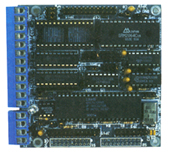
The RTC31/52 is our all-time best price-performer. The RTC31 is a 3.5" x 3.5" real-time controller that uses an 8031 processor and is intended for OEM assembly-language applications. The RTC52 uses the same PC board but has a Micromint 80C52-BASIC processor instead of an 8031. With BASIC, the RTC52 is software compatible with our BCC52 series, as well as allowing for onboard program development using a common RS-232 terminal. The 80C52-BASIC processor can also be jumper-selected to function as an 80C31/80C32 processor.
RTC180
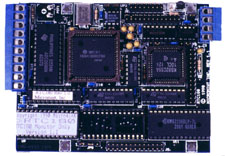
Take an advanced, new-generation microprocessor, make it completely software compatible with one of the industry's most respected microprocessors, put it in a compact, low-power package, and what do you have? You have an OEM's dream! You also have the RTC180, a member of our amazing RTC family that has an installed base of thousands.
The RTC180 uses the Zilog Z180 processor, an established favorite of application design engineers worldwide. The RTC180 provides plenty of memory with 96 KB of system memory: 32-KB SRAM and either 32-KB SRAM plus 32-KB EPROM or 64-KB EPROM, plus 128 bytes of configuration EEPROM. The RTC180's onboard I/O is impressive as well, with two serial ports (one full-duplex RS-232 and one half-duplex RS-485), 24 bits of TTL parallel I/O, and an 8-channel 8-bit ADC. The RTC180 wraps all of this power and versatility into the 3.5" x 4.5" RTC form factor.
Learn More...
RTC-320/52Plus
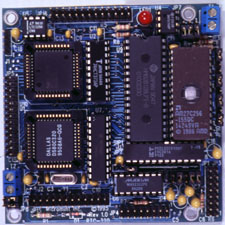
One of Micromint's hottest-selling products for the past five years has been the RTC31/52 stackable controller. It has been a leading price/performance choice among our customers. With our new RTC320 and RTC52-Plus boards, we have expanded the value of that relationship even more.
Occupying the same small 3.5" x 3.5" RTC footprint and 5-V-only power, the RTC320 uses the new Dallas Semiconductor 80C320, which is 8031 code-compatible and 35 times faster. At 33 MHz, the RTC320 is an 8-MIPS controller! Along with the new powerful processor, the RTC320 board accommodates up to 192 KB of memory, 2 serial ports (RS-232 and RS-485), 24 bits of TTL parallel I/O, and a 2-channel 12-bit ADC. The RTC320 puts some real firepower under the abundant variety of RTC I/O expansion boards. Plugging in your favorite ICE or EPROM emulator is the easiest way to develop code. For the diehards who like to twiddle the bits directly, we have a ROM monitor specifically designed for the Dallas '320.
RTC-HC11
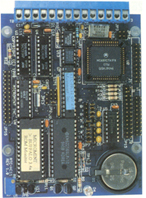
Offering exceptional value in a single-board embedded controller, our RTC-HC11 combines all of the most-asked-for features into a small 3.5" x 4.5" package at a reasonable price. Featuring the popular Motorola MC68HC11 microcontroller, the RTC-HC11 gives you an exceptional list of specifications at a very affordable price.
Software development can be done directly on the RTC-HC11 target system using assembly language or BASIC-11, an extremely fast integer BASIC interpreter with dedicated keywords for I/O port, A/D converter, timer, interrupt, and EEPROM support. In addition, a BASIC program can be saved on the onboard battery-backed static RAM or burned into an autostarting EPROM.
Processor Boards Expansion Boards
Expansion Boards
RTC-AD12E

The RTC-AD12E is our newest addition to the RTC line. It is affered in 3 configurations, the EA, EB and ED versions. The EA version offers an 8-channel (4-channel differential) 12 bit analog-to-digital converter. The EB version includes the 4-channel digital-to-analog converter for the RTC bus. The ED version offers only the DAC. Perfect for those applications that involve more meticulous data collection, this peripheral board is the culmination of high performance and compact packaging.
RTC-BUF50
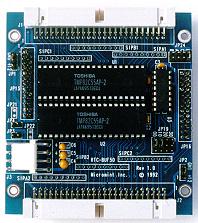
RTC-BUFIO
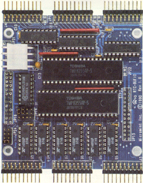
The RTC-BUFIO is a buffered, high-voltage, digital input/output expansion board designed to directly power external devices (such as relays and indicators) and protect digital inputs from real-world interfacing anomalies.
RTC-SIR

RTC-SIR is a multifunction expansion board offering a combination of four independent I/O subsystems: bidirectional TTL parallel I/O, RS-232 serial I/O, infrared transmit and receive, and 16-bit programmable timers.
RTC180
 Take an advanced, new-generation microprocessor, make it completely software compatible with one of the industry's most respected microprocessors, put it in a compact, low-power package, and what do you have? You have an OEM's dream! You also have the RTC180, a member of our amazing RTC family that has an installed base of thousands.
Take an advanced, new-generation microprocessor, make it completely software compatible with one of the industry's most respected microprocessors, put it in a compact, low-power package, and what do you have? You have an OEM's dream! You also have the RTC180, a member of our amazing RTC family that has an installed base of thousands.The RTC180 uses the Zilog Z180 processor, an established favorite of application design engineers worldwide. The RTC180 provides plenty of memory with 96 KB of system memory: 32-KB SRAM and either 32-KB SRAM plus 32-KB EPROM or 64-KB EPROM, plus 128 bytes of configuration EEPROM. The RTC180's onboard I/O is impressive as well, with two serial ports (one full-duplex RS-232 and one half-duplex RS-485), 24 bits of TTL parallel I/O, and an 8-channel 8-bit ADC. The RTC180 wraps all of this power and versatility into the 3.5" x 4.5" RTC form factor.
Fully compatible with the entire line of RTC expansion I/O boards, the RTC180 keeps the power requirements simple with its +5-V-only operation. Truly a developer's dream, the RTC180 is an ideal solution for today's difficult applications.
| Processor: | Z180 | Clock speed: | 9.216 MHz | |
| Max Memory: | 96 KB | SRAM/EPROM: | 64 KB/64 KB | |
| Digital I/O: | 24 bits, PPI | Serial Ports: | 1 RS-232, 1 RS-485 | |
| ADC (sample rate): | 05 V, 8 chan., 8 bits (10k) | Timers: | 2 | |
| External Interrupts: | 4 | Real-time Clock: | Yes, SmartWatch socket (opt.) | |
| Size: | 3.5" x 4.5" | Power (fully loaded): | +5 V at 300 mA | |
| Dev. Software: | Optional | ROM Monitor: | Yes or BASIC-180 | |
| Industrial Temp. Available: | Yes | |||
This email address is being protected from spambots. You need JavaScript enabled to view it. or Call for Pricing
RTC320/52 Plus
 One of Micromint's hottest-selling products for the past five years has been the RTC31/52 stackable controller. It has been a leading price/performance choice among our customers. With our new RTC320 and RTC52-Plus boards, we have expanded the value of that relationship even more.
One of Micromint's hottest-selling products for the past five years has been the RTC31/52 stackable controller. It has been a leading price/performance choice among our customers. With our new RTC320 and RTC52-Plus boards, we have expanded the value of that relationship even more.Occupying the same small 3.5" x 3.5" RTC footprint and 5-V-only power, the RTC320 uses the new Dallas Semiconductor 80C320, which is 8031 code-compatible and 35 times faster. At 33 MHz, the RTC320 is an 8-MIPS controller! Along with the new powerful processor, the RTC320 board accommodates up to 192 KB of memory, 2 serial ports (RS-232 and RS-485), 24 bits of TTL parallel I/O, and a 2-channel 12-bit ADC. The RTC320 puts some real firepower under the abundant variety of RTC I/O expansion boards. Plugging in your favorite ICE or EPROM emulator is the easiest way to develop code. For the diehards who like to twiddle the bits directly, we have a ROM monitor specifically designed for the Dallas '320.
| Processor: | Dallas 80C320 | Clock speed: | 11/22/33 MHz | |
| Max Memory: | 192 KB | SRAM/EPROM: | 110 KB/64 KB | |
| Digital I/O: | 24 bits, PIA | Serial Ports: | 2 (RS-232 & RS-232/-485) | |
| ADC (sample rate): | 05 V, 2 chan., 12 bits (11.1k) | Timers: | 3 | |
| External Interrupts: | 2 | Real-time Clock: | Yes, SmartWatch socket (opt.) | |
| Size: | 3.5" x 3.5" | Power (fully loaded): | +5 V 33 MHz: 250 mA; 11 MHz: 125 mA |
|
| Dev. Software: | Optional | ROM Monitor: | Yes |
This email address is being protected from spambots. You need JavaScript enabled to view it. or Call for Pricing
RTC31/52
 The RTC31/52 is our all-time best price-performer. The RTC31 is a 3.5" x 3.5" real-time controller that uses an 8031 processor and is intended for OEM assembly-language applications. The RTC52 uses the same PC board but has a Micromint 80C52-BASIC processor instead of an 8031. With BASIC, the RTC52 is software compatible with our BCC52 series, as well as allowing for onboard program development using a common RS-232 terminal. The 80C52-BASIC processor can also be jumper-selected to function as an 80C31/80C32 processor.
The RTC31/52 is our all-time best price-performer. The RTC31 is a 3.5" x 3.5" real-time controller that uses an 8031 processor and is intended for OEM assembly-language applications. The RTC52 uses the same PC board but has a Micromint 80C52-BASIC processor instead of an 8031. With BASIC, the RTC52 is software compatible with our BCC52 series, as well as allowing for onboard program development using a common RS-232 terminal. The 80C52-BASIC processor can also be jumper-selected to function as an 80C31/80C32 processor.
The RTC31/52 was designed to provide a minimal configuration for cost-conscious applications. It can be greatly expanded to perform more extensive control and data-acquisition tasks while maintaining the same small 3.5" x 3.5" footprint by using a stacked-board expansion system. Additional analog and digital I/O boards are piggybacked on top of the processor board and secured with stand-offs.
Click here to download the RTC31/52 Datasheet.
|
Processor: |
80C31/80C52 |
|
Clock speed: |
11.05 MHz |
|
Max Memory: |
64 KB |
|
SRAM/EPROM: |
32 KB/32 KB |
|
Digital I/O: |
12 bits* |
|
Serial Ports: |
1 RS-232-485 |
|
ADC (sample rate): |
0 |
|
Timers: |
2 |
|
External Interrupts: |
2 |
|
Real-time Clock: |
Yes, SmartWatch socket (opt.) |
|
Size: |
3.5" x 3.5" |
|
Power (fully loaded): |
+5 V at 125 mA |
|
Dev. Software: |
Optional |
|
ROM Monitor: |
Optional/BASIC-52 |
|
Industrial Temp. Available: |
Yes |
|
||
|
*When using the 80C52, 8 bits are accessible directly from BASIC. The other 4 can be controlled using assembly language calls. |
||||
This email address is being protected from spambots. You need JavaScript enabled to view it. or Call for Pricing
RTC-HC11
 Offering exceptional value in a single-board embedded controller, our RTC-HC11 combines all of the most-asked-for features into a small 3.5" x 4.5" package at a reasonable price. Featuring the popular Motorola MC68HC11 microcontroller, the RTC-HC11 gives you an exceptional list of specifications at a very affordable price.
Offering exceptional value in a single-board embedded controller, our RTC-HC11 combines all of the most-asked-for features into a small 3.5" x 4.5" package at a reasonable price. Featuring the popular Motorola MC68HC11 microcontroller, the RTC-HC11 gives you an exceptional list of specifications at a very affordable price.Software development can be done directly on the RTC-HC11 target system using assembly language or BASIC-11, an extremely fast integer BASIC interpreter with dedicated keywords for I/O port, A/D converter, timer, interrupt, and EEPROM support. In addition, a BASIC program can be saved on the onboard battery-backed static RAM or burned into an autostarting EPROM.
| Processor: | 68HC11A1 | Clock speed: | 8 MHz | |
| Max Memory: | 64 KB | SRAM/EPROM: | 64 KB/64 KB | |
| Digital I/O: | 13 bits | Serial Ports: | 1 RS-232/485 | |
| ADC (sample rate): | 05 V, 8 chan., 8 bits (50k) | Timers: | 1 | |
| External Interrupts: | 2 | Real-time Clock: | Yes | |
| Size: | 3.5" x 4.5" | Power (fully loaded): | +5 V at 75 mA | |
| Dev. Software: | Optional | ROM Monitor: | Yes or BASIC-11 | |
| Industrial Temp. Available: | Yes | |||
RTC-AD12E
RTC-AD12E™ Analog Expansion Board
 The RTC-AD12E is our newest addition to the RTC line. It is affered in 3 configurations, the EA, EB and ED versions. The EA version offers an 8-channel (4-channel differential) 12 bit analog-to-digital converter. The EB version includes the 4-channel digital-to-analog converter for the RTC bus. The ED version offers only the DAC. Perfect for those applications that involve more meticulous data collection, this peripheral board is the culmination of high performance and compact packaging. The RTC-AD12E’s 12-bit-plus-sign A/D converter performs more than 20,000 conversions per second within an input range of -5V to+5V. The ADC incorporates special input overvoltage protection and input scaling which is especially useful for low-level signals or high-noise environments. Each channel is independently gain programmable for 1, 2, 4, or 8 times gain. The RTC-AD12E also has four buffered, fast-action DAC outputs. Each channel can have separate output scaling.
The RTC-AD12E is our newest addition to the RTC line. It is affered in 3 configurations, the EA, EB and ED versions. The EA version offers an 8-channel (4-channel differential) 12 bit analog-to-digital converter. The EB version includes the 4-channel digital-to-analog converter for the RTC bus. The ED version offers only the DAC. Perfect for those applications that involve more meticulous data collection, this peripheral board is the culmination of high performance and compact packaging. The RTC-AD12E’s 12-bit-plus-sign A/D converter performs more than 20,000 conversions per second within an input range of -5V to+5V. The ADC incorporates special input overvoltage protection and input scaling which is especially useful for low-level signals or high-noise environments. Each channel is independently gain programmable for 1, 2, 4, or 8 times gain. The RTC-AD12E also has four buffered, fast-action DAC outputs. Each channel can have separate output scaling.
Click here to download the RTC-AD12E datasheet.
| Features | 8-channel, single or 4-channel differential input, 12-bit plus sign A/D converter, 50k sample/s 4-channel, 12-bit D/A converter. Programmable A/D input gain of 1,2,4, or 8, channel selectable |
Size: | 3.5" x 3.5" | |
| Power (fully loaded): | +5 V @ 175 mA for A/D converter, bus or external ±12 V @ 40mA required for D/A converter | Industrial Temp. Available: | Yes |
Call for Custom Configurations
RTC-SIR
| Features | RS-232 serial port, 50-38.4k bps. Three 16-bit programmable timers (8254). 24 bits TTL I/O, 8255 PIA, 40-kHz modulated-to- digital on/off, infrared smit, and 40-kHz receiver. | Size: | 3.5" x 3.5" | |
| Power (fully loaded): | +5 V @ 150 mA | Industrial Temp. Available: | Yes |






